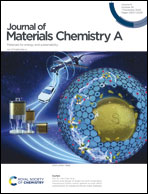A robust spring-like lamellar VO/C nanostructure for high-rate and long-life potassium-ion batteries†
Abstract
Metal oxides usually exhibit low reversible capacity, inferior rate capability and limited lifespan for potassium-ion batteries due to the large radius of K+. Herein, a spring-like lamellar nanostructure composed of VO nanoparticles embedded in amorphous carbon layers (VO/C) has been rationally designed. It exhibits a large capacity of 345 mA h g−1 at 0.1 A g−1 after 400 cycles, excellent stability of 241 mA h g−1 at 1 A g−1 over 1000 cycles and outstanding rate performance of 104 mA h g−1 at 15 A g−1, superior to most reported transition metal oxides for PIBs. The in situ formed lamellar VO/C nanostructure can accommodate the volume variation during cycling. Density functional theory (DFT) calculations reveal that the hybrid VO/C structure significantly increases the electronic states at the Fermi level, thus improving the electronic conductivity, and reduces the K+ diffusion barrier (from 1.95 eV of VO to 1.19 eV), which contributes to its large capacity and superior rate performance. A PIB full cell exhibits 168 mA h g−1 at 2 A g−1 and 80% capacity retention over 500 cycles. This work provides some insights into the rational design of metal oxide-based anodes for high-performance PIBs.



 Please wait while we load your content...
Please wait while we load your content...